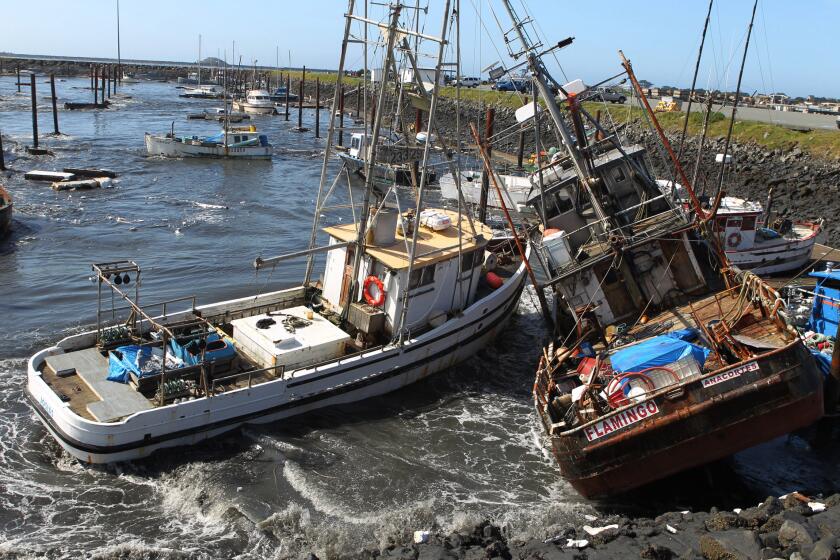Small Blasts Will Yield Quake Data : Science: Federal geologists will set off a series of explosions from Seal Beach to the Mojave Desert to map the L.A. Basin.
- Share via
SEAL BEACH — Federal scientists will be setting off small, underground explosions and undersea bursts of compressed air over the next two weeks, seeking a “CAT scan” of the Los Angeles Basin for earthquake study.
The seismic waves created by the mini-explosions and compressed air will be measured by 600 seismographs in Orange and Los Angeles counties and will help scientists learn when earthquakes are likely to happen and where they will be strongest.
Beginning today, bursts of compressed air will be shot from gun mechanisms trailing the research vessel Ewing as it makes a seven-day voyage from Long Beach Harbor to San Clemente Island and back, a spokesman for the U.S. Geological Survey said. The bursts generate sound waves that travel through water and rock and can produce an image of the Earth’s crust beneath the Los Angeles Basin.
In Orange County, only Seal Beach residents may hear some dull thuds at night from Oct. 23 to 30, when the underground explosions will occur, said Jim Mori, survey spokesman. The blasts will range from 250 pounds of explosives in most urban sites to a maximum of 4,000 pounds in a remote area of the Mojave Desert.
“This is the first time an imaging map survey has been done for Southern California,” Mori said. “We have done tests like this for many years and recently completed one in Northern California. It’s to give us the first look at the underground geologic structures. That includes things like faults, the roots of mountains and, generally, what the shapes of the Los Angeles Basin look like.”
Of special note, Mori said, is the potential to map and provide geologic information about blind thrust faults, similar to the fault that produced the Jan. 17 Northridge earthquake. Such a fault, Mori said, produces vertical motion, unlike a strike-slip fault, which produces horizontal motion. The “blind” aspect refers to a fault that does not come to the surface and is not readily identifiable, unlike California’s San Andreas fault, which is plainly visible, Mori said.
“It’s easy to see that blind, or buried, thrust faults are a lot more difficult to identify,” Mori said, “and (that’s) one of the reasons we need the special sensing techniques to find them.”
*
Beginning Oct. 23, a series of about 60 small explosions will be detonated in drill holes between 60 and 130 feet deep. Mori said that seismographs will be deployed from Seal Beach northeast in nearly a straight line into Los Angeles County, through the San Gabriel Mountains and into the Mojave Desert. Mori said this path was chosen because it crosses the Los Angeles Basin at a less populated angle and it passes locations where major earthquakes occurred in Long Beach, Whittier and Sierra Madre.
Mori said the blasts would have no significant environmental impact, according to numerous previous tests and environmental assessments by the U.S. Geological Survey. The explosive used is ammonium nitrate, the same ingredient in many fertilizers, mixed with inert additives.
Scientists and technicians generally detonate the explosives from a few hundred feet away, and occasionally some gravel is ejected from atop the explosives and lands within 100 feet of the blast, Mori said.
Seal Beach City Manager Jerry L. Bankston said that two U.S. Geological Survey representatives made a presentation before the City Council about two weeks ago and won unanimous approval for the project.
The representatives assured council members that the blasts would have no effect on artillery at the naval weapons station, Bankston said.
More to Read
Sign up for Essential California
The most important California stories and recommendations in your inbox every morning.
You may occasionally receive promotional content from the Los Angeles Times.










